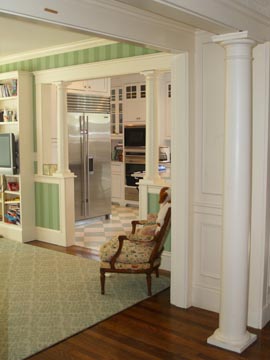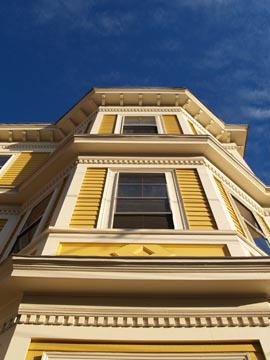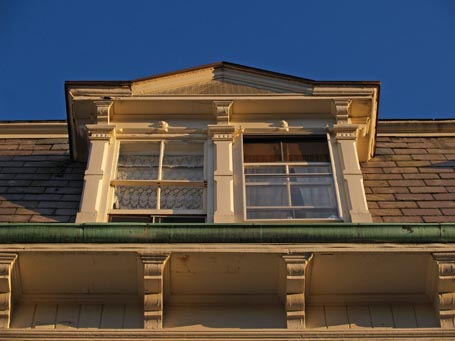
Entries from September 1, 2009 - September 30, 2009
Web tour: Boston Globe: The meaning is the metaphor in thought and design
I’m fascinated by the mind/body connection. This may be, in part, because I’m an architect. I believe that shaping spaces, which our bodies inhabit, can shape the minds inhabiting them, and vice versa. So I often find Drake Bennett’s writing about cognitive and behavioral science in the Ideas Section of the Globe intriguing.
This week Bennett wrote about thinking literally. Bennett reports that cognitive scientists are studying how commonly understood metaphors are the “keys to the structure of thought”. When we describe someone as warm, a situation as heavy, a goal as lofty, or a problem as hard, we are using what scientists call “primary metaphors”. These they believe are more than communication tools but “markers of the roots of thought itself”. Scientists are taking metaphors literally. According to Bennett, "without our body's instinctive sense for temperature -- or position, texture, size, shape, or weight -- abstract concepts like kindness and power, difficulty and purpose, and intimacy and importance would simply not make any sense to us".
To study their theory, scientists are conducting experiments “altering one side of the metaphorical equation to show how it changes the other”. Give folks warm cups of coffee; then ask them to assess a person described to them, and they find that person to be warm. Give some other folks iced coffee; ask them to assess a person described to them, and they find that person to be cold. O.K., it's a little more complicated than that, but, yikes. Are we really that literal and that suggestible? Looks like it. Bennett writes that “metaphors reveal the extent to which we think with our bodies”.
This would suggest that subtle changes in our environments: how soft, hard, dark, light, smooth, or rough they are would influence how soft, hard, dark, light, smooth, or rough we feel. It’s always fun when common sense prevails.
Take a look at other House Enthusiast posts (here and here) which also reference Drake Bennett’s writing for Ideas.
by Katie Hutchison for House Enthusiast
House plans that flow
 Click on this photo to see the Newton Kitchen Reno & Mud Room Addition.Check out the October/November 2009 issue of Fine Homebuilding to see my latest "Drawing Board" column. In it, I write about two primary circulation patterns which often yield houses that flow. Certain circulation patterns are better paired with certain house-plan types. To enhance flow in a new or existing home, team the circulation pattern and house-plan type which are most simpatico. Click here for a PDF of the design column. Issue #206, October/November 2009. Reprinted with permission copyright 2009, The Taunton Press.
Click on this photo to see the Newton Kitchen Reno & Mud Room Addition.Check out the October/November 2009 issue of Fine Homebuilding to see my latest "Drawing Board" column. In it, I write about two primary circulation patterns which often yield houses that flow. Certain circulation patterns are better paired with certain house-plan types. To enhance flow in a new or existing home, team the circulation pattern and house-plan type which are most simpatico. Click here for a PDF of the design column. Issue #206, October/November 2009. Reprinted with permission copyright 2009, The Taunton Press.
Visit the KHS publications page to see other magazine columns and articles I've written.
by Katie Hutchison for House Enthusiast
Web tour: Things That Inspire: Heads up
 Click on this photo to see it in the KHS photo note cards/prints gallery.Surf the web this week, and you’ll find the House Enthusiast Primer on the third dimension referenced at Things That Inspire. Using abundant interior images, Things That Inspire translates the concepts described in the House Enthusiast Primer to interiors via photos illustrating a range of spatial depths and heights in well-appointed homes. Both webposts invite readers to train their eyes on a dimension vital to shaping our experience. Whether the third dimension is expressed overhead, in a framed view corridor, on a textured surface, by an articulated stair, or with a spatial illusion, our environments are richer for having explored it.
Click on this photo to see it in the KHS photo note cards/prints gallery.Surf the web this week, and you’ll find the House Enthusiast Primer on the third dimension referenced at Things That Inspire. Using abundant interior images, Things That Inspire translates the concepts described in the House Enthusiast Primer to interiors via photos illustrating a range of spatial depths and heights in well-appointed homes. Both webposts invite readers to train their eyes on a dimension vital to shaping our experience. Whether the third dimension is expressed overhead, in a framed view corridor, on a textured surface, by an articulated stair, or with a spatial illusion, our environments are richer for having explored it.
by Katie Hutchison for House Enthusiast
Design snapshot: Victorian dormer
 Click on this photo to see it in the KHS photo note cards/prints gallery.Since one House Enthusiast reader noted at Things That Inspire how I really have “a thing for properly designed dormers,” I thought I’d prove him right with another dormer post.
Click on this photo to see it in the KHS photo note cards/prints gallery.Since one House Enthusiast reader noted at Things That Inspire how I really have “a thing for properly designed dormers,” I thought I’d prove him right with another dormer post.
This dormer with Victorian detailing adorns a mansard slate roof. The chamfered pilasters on either side of the 2/2 double-hung windows add depth and interest, as well as significance to this rooftop jewel. The main roof eave brackets are echoed in the mini-me styling of the dormer eave brackets which receive the eave overhang. Thanks to the dormer’s low-pitch gable with flat-roofed extensions, it resides below the transition trim between the mansard’s two roof slopes. Window head trim punctuated with circular nodes further animate the tableau. It isn’t difficult to conjure an abstract face within the composition.
Maybe you too will develop “a thing for properly designed dormers.” I can only hope.
Click here, here, here, and here to see some more of my writing about dormers.
by Katie Hutchison for House Enthusiast
Essex National Heritage Area 2009 Trails and Sails
 Don’t miss the next two weekends of free outdoor and cultural activities in Essex County as part of the 2009 Trails and Sails experience. Visit their extensive website to plan your itinerary. You might want to consider the Cox Reservation Walk in Essex or the Guide’s Favorite’s at Beauport, the Sleeper-McCann House in Gloucester. Perhaps you’d like to climb aboard a Yankee Whale Watch in Gloucester or a pontoon boat to go Cruising the Essex River. Join the Ipswich Maritime Walking Tour to stroll the Historic South Green and the shores of the Ipswich River. Visit the Italian and Rose formal gardens at Maudslay State Park as part of the Newburyport Tour + Tea in Formal Gardens. Partake in a Chestnut Street Stroll among its sea captain houses or Lunch Hour at the Gedney House c. 1665 in Salem. Check the Trails and Sails website for dates and times. Enjoy some of New England’s treasures north of Boston.
Don’t miss the next two weekends of free outdoor and cultural activities in Essex County as part of the 2009 Trails and Sails experience. Visit their extensive website to plan your itinerary. You might want to consider the Cox Reservation Walk in Essex or the Guide’s Favorite’s at Beauport, the Sleeper-McCann House in Gloucester. Perhaps you’d like to climb aboard a Yankee Whale Watch in Gloucester or a pontoon boat to go Cruising the Essex River. Join the Ipswich Maritime Walking Tour to stroll the Historic South Green and the shores of the Ipswich River. Visit the Italian and Rose formal gardens at Maudslay State Park as part of the Newburyport Tour + Tea in Formal Gardens. Partake in a Chestnut Street Stroll among its sea captain houses or Lunch Hour at the Gedney House c. 1665 in Salem. Check the Trails and Sails website for dates and times. Enjoy some of New England’s treasures north of Boston.
by Katie Hutchison for House Enthusiast















